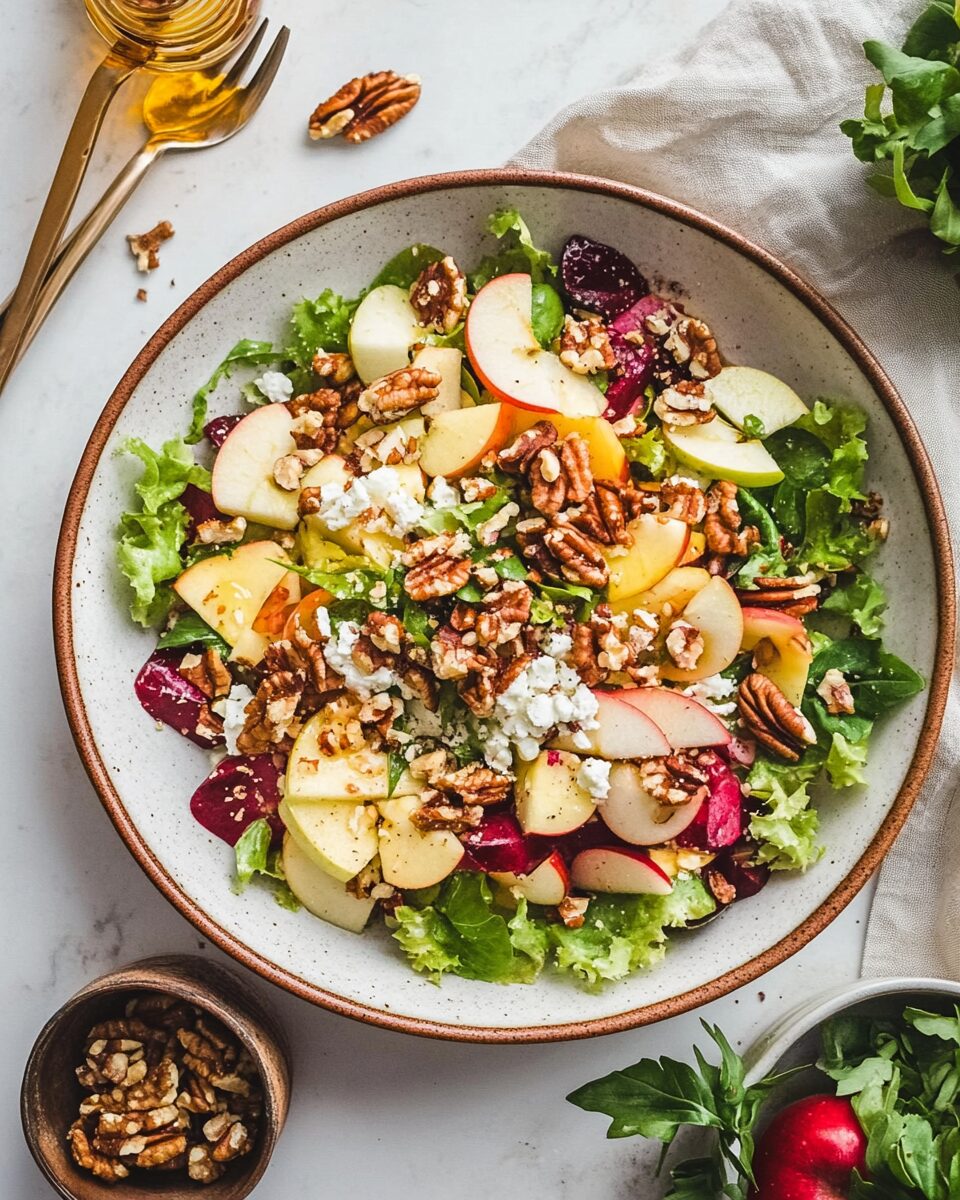This Apple Walnut Salad is a delightful blend of crisp apples, crunchy toasted walnuts, creamy cheese, and a tangy vinaigrette. It’s a fresh and vibrant salad perfect for fall gatherings or as a side dish to complement any main course.
Full Recipe:
Ingredients
- 6–8 cups mixed greens (like arugula, baby spinach, or spring mix)
- 2 apples (such as Honeycrisp or Pink Lady), thinly sliced
- 1/2 cup candied or toasted walnuts
- 1/3 cup crumbled goat cheese or feta
- 1/4 small red onion, thinly sliced
- 1/4 cup pomegranate seeds (optional)
For the dressing:
- 1/4 cup olive oil
- 1 tablespoon apple cider vinegar
- 1 tablespoon maple syrup or honey
- 1 teaspoon Dijon mustard
- Salt and pepper to taste
Directions
-
In a large serving bowl, layer the greens, sliced apples, walnuts, cheese, red onion, and pomegranate seeds.
-
In a separate small bowl or jar, whisk together olive oil, apple cider vinegar, maple syrup or honey, Dijon mustard, salt, and pepper until well combined.
-
Drizzle the dressing over the salad just before serving and gently toss to coat.
Nutrients
Estimated per serving (serves 4–6):
- Calories: 260
- Protein: 5g
- Carbohydrates: 18g
- Sugars: 11g
- Fiber: 3g
- Fat: 20g
- Saturated Fat: 4g
- Sodium: 240mg
A Brief History of Apple and Walnut Pairings
The pairing of apples and walnuts dates back centuries. Apples have been cultivated for over 4,000 years, and their integration into salads likely began when fresh produce became more widely appreciated in European cuisine. Walnuts, native to Central Asia and the Mediterranean, were prized not only for their rich, oily texture but also for their perceived health benefits. As salads evolved from simple leafy mixtures into full-bodied, layered dishes, combining fruits and nuts became a natural progression. Today, the apple-walnut combination is a classic, celebrated in everything from baked goods to elegant salads.
Flavor Profile and Texture Harmony
The appeal of this salad lies in its interplay of textures and tastes. Crisp apple slices provide a juicy crunch, while walnuts introduce a toasted, slightly bitter nuttiness. Add in creamy crumbles of goat cheese or feta, a peppery bed of arugula or spinach, and the zing of a vinaigrette, and you’ve got a perfectly balanced dish. The sweetness of apples offsets the acidity of vinegar or citrus in the dressing, while the nuts ground the composition with earthy depth. Each bite becomes a flavorful journey, with sharp, sweet, and savory notes dancing on the palate.
Why It’s Perfect for Fall (But Works Year-Round)
Though often associated with fall, thanks to apple harvests and cozy textures, this salad transcends the seasons. During autumn, it echoes the flavors of the orchard and the warmth of spiced nuts or cider-based dressings. In spring or summer, it takes on a refreshing tone—cool, light, and hydrating. Apples are now available year-round, and with versatile options for greens, cheese, and toppings, it’s easy to adapt this salad to any time of year without compromising its core appeal.
Health Benefits and Nutritional Power
This salad isn’t just a feast for the senses—it’s a nutritional powerhouse. Apples are rich in dietary fiber, especially if the skins are left on, aiding in digestion and blood sugar control. They’re also loaded with vitamin C and various antioxidants. Walnuts contribute omega-3 fatty acids, which are beneficial for heart and brain health. They also provide protein, magnesium, and anti-inflammatory compounds. When you add dark leafy greens, like arugula or spinach, you’re incorporating iron, calcium, and vitamins A, C, and K.
The addition of goat cheese or feta gives you a modest dose of calcium and healthy fats, while a vinaigrette made with olive oil brings monounsaturated fats that support cholesterol balance. As a whole, the Apple Walnut Salad is a smart choice for anyone seeking to eat well without sacrificing taste.
Versatile Ingredients and Customization Options
One of the greatest strengths of this salad is its adaptability. It serves as a blank canvas for creativity:
-
Apples: Honeycrisp and Pink Lady offer a balance of sweetness and tartness, but Granny Smith adds sharpness, and Fuji brings mellow sweetness.
-
Greens: While mixed greens or baby spinach are common, you can also use kale for a more robust texture or romaine for added crunch.
-
Cheese: Goat cheese adds tang, feta offers a salty bite, blue cheese brings pungency, and even shaved parmesan can work.
-
Nuts: Walnuts are the classic choice, but pecans, almonds, or pistachios can offer new dimensions.
-
Add-ins: Pomegranate seeds, dried cranberries, sliced grapes, or even roasted sweet potatoes can complement or elevate the core ingredients.
These substitutions make it easy to align the salad with dietary preferences or pantry availability.
Perfect Pairings and Meal Ideas
Apple Walnut Salad is incredibly versatile in meal planning. It can stand alone as a light lunch or be elevated into a full dinner with a protein addition. Grilled chicken, salmon, or turkey breast pair beautifully. For a vegetarian take, roasted chickpeas or quinoa can boost the protein content while keeping the dish plant-based.
As a side, this salad adds freshness to heavier meals—think alongside creamy soups, savory tarts, or rich pasta dishes. It’s also a fantastic contrast to holiday roasts, providing brightness and balance on festive tables.
For drinks, consider pairing it with a light white wine like Sauvignon Blanc, a crisp cider, or a sparkling water infused with citrus or herbs.
Make-Ahead Tips and Storage
Planning ahead? Apple Walnut Salad can be partially prepped in advance. The dressing can be made up to 5 days early and stored in a jar in the fridge. Nuts can be toasted ahead and kept in a sealed container, and greens washed and stored in paper towel-lined bags for freshness.
One challenge is the browning of apples once cut. To prevent oxidation, you can toss sliced apples with a bit of lemon juice and store them separately until just before serving.
Once fully dressed, the salad is best eaten immediately, as the vinaigrette can wilt the greens. If you anticipate leftovers, serve the dressing on the side and only dress individual portions.
Seasonal Variations and Themes
This recipe lends itself well to seasonal adaptations:
-
Fall/Winter: Add roasted butternut squash or beets, use apple cider vinaigrette, and sprinkle in dried cranberries or figs.
-
Spring/Summer: Use berries like strawberries or raspberries, lighten the dressing with lemon juice, and add mint or basil for a fresh twist.
You can even theme it for special occasions. For a Thanksgiving version, consider spiced candied pecans and a maple-Dijon dressing. For a romantic dinner, serve with pink apple slices and rosewater-accented vinaigrette.
Serving and Presentation Tips
The visual appeal of Apple Walnut Salad is part of its charm. Arrange the sliced apples in a fan or spiral atop the greens for an elegant look. Scatter nuts and cheese evenly, and drizzle the dressing at the table for a fresh touch. For added texture, consider a final grind of black pepper or a dusting of lemon zest.
If serving buffet-style, consider offering a deconstructed version where guests can assemble their own bowls from ingredient stations. This also helps accommodate allergies or dietary preferences.
Cultural Significance and Culinary Trends
Apple Walnut Salad reflects a broader culinary trend: the integration of fruit and nuts into savory dishes. Once seen primarily in desserts or cheese boards, fruits like apples now play starring roles in salads, grain bowls, and entrees. This blending of sweet and savory showcases a more global and nuanced understanding of flavor.
It also represents the movement toward whole food, nutrient-dense eating, where flavor, texture, and health intersect. The rise in popularity of Mediterranean and California cuisine has brought fresh, layered salads like this into mainstream dining.
Sustainability and Local Sourcing
Choosing locally grown apples and walnuts not only improves flavor—it also supports local agriculture and reduces carbon footprint. Many regions offer farmers markets or community-supported agriculture (CSA) programs where you can source ingredients freshly harvested and minimally transported.
In addition, making your own vinaigrette eliminates preservatives and unnecessary packaging. Even small choices, like reusable containers or buying bulk nuts, contribute to more sustainable kitchen habits.
Conclusion
The Apple Walnut Salad is far more than a side dish—it’s a culinary canvas rich in flavor, tradition, and nutrition. From its historical roots to modern-day appeal, it offers endless room for creativity, seasonal adaptation, and personalization. Whether you’re building a quick weekday meal or preparing a festive feast, this salad delivers freshness, texture, and health in every bite.






